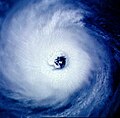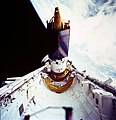STS-43
| Missionsemblem | |||||
|---|---|---|---|---|---|
 | |||||
| Missionsstatistik | |||||
| Missionsnavn: | STS-43 | ||||
| Rumagentur: | NASA | ||||
| Rumfærge: | Atlantis (9) | ||||
| Antal besætningsmedlemmer: | 5 | ||||
| Affyringsrampe: | LC-39B (KSC) | ||||
| Opsendelse: | 2. august 1991 | ||||
| Landing: | 11. august 1991 | ||||
| Landet på: | KSC | ||||
| Varighed: | 8 døgn, 21 timer | ||||
| Foto af besætningen | |||||
 | |||||
| Navigation | |||||
| |||||
STS-43 (Space Transportation System-43) var Atlantis 9. rumfærge-mission. Den blev opsendt d. 2. august 1991 og vendte tilbage den d. 11. august 1991.
Missionen satte kommunikationssatellitten Tracking and Data Relay Satellite (TDRS-5) i kredsløb[1].
Besætning

 John Blaha (kaptajn)
John Blaha (kaptajn)
 Michael Baker (pilot)
Michael Baker (pilot)
 Shannon Lucid (1. missionsspecialist)
Shannon Lucid (1. missionsspecialist)
 James Adamson (2. missionsspecialist)
James Adamson (2. missionsspecialist)
 David Low (3. missionsspecialist)
David Low (3. missionsspecialist)
Missionen
Orkanen Fefa set fra rumfærgen
Hovedartikler:
| Wikimedia Commons har medier relateret til: |
Eksterne henvisninger
- STS-43 NASA (engelsk)
- STS-43 Arkiveret 13. august 2010 hos Wayback Machine NASA KSC (engelsk)
- Tracking and Data Relay Satellite System (TDRSS) Arkiveret 20. marts 2009 hos Wayback Machine NASA (engelsk)
| ||||||||
| ||||||||||||||||||||
Medier brugt på denne side
STS-27 Mission Insignia
The primary payload of the STS-43 mission, Tracking and Data Relay Satellite-E (TDRS-E) attached to an Inertial Upper Stage (IUS) was photographed at the moment of its release from the cargo bay of the Space Shuttle Orbiter Atlantis. The TDRS-E was boosted by the IUS into geosynchronous orbit and positioned to remain stationary 22,400 miles above the Pacific Ocean southwest of Hawaii. The TDRS system provides almost uninterrupted communications with Earth-orbiting Shuttles and satellites, and had replaced the intermittent coverage provided by globe-encircling ground tracking stations used during the early space program. The TDRS can transmit and receive data, and track a user spacecraft in a low Earth orbit. The IUS is an unmarned transportation system designed to ferry payloads from low Earth orbit to higher orbits that are unattainable by the Shuttle. The launch of STS-43 occurred on August 2, 1991.
SVG version of PNG Space Shuttle Logo/Patch.
Space Shuttle Atlantis takes flight on its STS-27 mission on December 2, 1988, 9:30 a.m. EST, utilizing 375,000 pounds thrust produced by its three main engines. The STS-27 was the third classified mission dedicated to the Department of Defense (DoD). After completion of mission, Orbiter Atlantis landed December 6, 1988, 3:36 p.m. PST at Edwards Air Force Base, California.
STS-43 Mission Insignia
- Designed by the astronauts assigned to fly on the mission, the STS 43 patch portrays the evolution and continuity of the USA's space program by highlighting 30 years of American manned space flight experience -- from Mercury to the Space Shuttle. The emergence of the Shuttle Atlantis from the outlined configuration of the Mercury space capsule commemorates this special relationship. The energy and momentum of launch are conveyed by the gradations of blue which mark the Shuttle's ascent from Earth to space. Once in Earth orbit, Atlantis' cargo bay opens to reveal the Tracking and Data Relay Satellite (TDRS) which appears in gold emphasis against the white wings of Atlantis and the stark blackness of space. A primary mission objective, the Tracking and Data Relay Satellite System (TDRSS) will enable almost continuous communication from Earth to space for future Space Shuttle missions. The stars on the patch are arranged to suggest this mission's numerical designation, with four stars left of Atlantis and three to the right.
The Pacific Ocean below can be seen looking down through the eye of Hurricane Fefa (exact location unknown). Fefa was a very strong Pacific Hurricane with a superb tightly formed eye. The tighter the eye in a circular storm, the stronger the winds within the gyre. At the time of this exposure, Fefa was located about midway between the California coast and Hawaii. Fefa dissipated at sea, failing to make landfall, and did no property damage. NASA photo ID: STS043-608-018.
The STS-30 patch depicts the joining of NASA's manned and unmanned space programs. The sun and inner planets of our solar system are shown with the curve connecting Earth and Venus symbolizing the shuttle orbit, the spacecraft trajectory toward Venus, and its subsequent orbit around our sister planet. A Spanish caravel similar to the ship on the official Magellan program logo commemorates the 16th century explorer's journey and his legacy of adventure and discovery. Seven stars on the patch honor the crew of Challenger. The five-star cluster in the shape of the constellation Cassiopeia represent the five STS-30 crewmembers - Astronauts David Walker, Ronald Grabe, Norman Thagard, Mary Cleave and Mark Lee - who collectively designed the patch.
STS-43 Official crew portrait shows astronauts standing in front of a landed space shuttle orbiter at sunset. Crewmembers, wearing launch and entry suits (LESs) and holding launch and entry helmets (LEHs), are (left to right) Mission Specialist (MS) Shannon W. Lucid, MS James C. Adamson, Commander John E. Blaha, MS G. David Low, and Pilot Michael A. Baker. The portrait was created using a double exposure.
Forfatter/Opretter: Kwamikagami, Licens: CC BY-SA 4.0
symbol of Mars. 16 × 16 pixel nominal dimensions, lines 2 pixel thick, square caps. Colour 75% blue: red=0 green=0 blue=191 (#0000BF).
The Space Shuttle Atlantis streaks skyward as sunlight pierces through the gap between the orbiter and ET assembly. Atlantis lifted off on the 42nd space shuttle flight at 11:02 a.m. EDT on August 2, 1991 carrying a crew of five and TDRS-E. A remote camera at the 275-foot level of the Fixed Surface Structure took this picture.
















